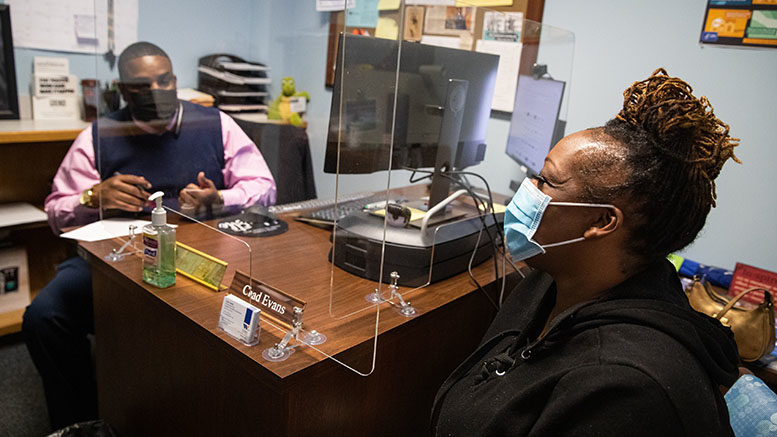While most colleges serve nontraditional students, it’s community colleges that cater to larger proportions of low-income households and underrepresented minorities. First-generation students and individuals learning English also use two-year institutions as vital access points for their collective futures and careers.
The Covid-19 pandemic created a stronger sense of urgency around these students, considering that community colleges lost almost 10% of their enrollment in fall 2020, according to the National Student Clearinghouse Research Center. Retaining people no longer credited toward college completion — a group known in academic parlance as “stop-outs” — is a core concern among administrators seeking to remove barriers to education.
This excerpt comes from the April/May issue of the Community College Journal, which the American Association of Community Colleges has published since 1930.
Preventing stop-outs from becoming “stay-outs” means re-enrolling students beset by debt, or targeting vulnerable demos close to graduation. High-touch advocacy includes data study, personalized outreach and a suite of wraparound services to ensure students remain enrolled.
“Sometimes life gets in the way, even when students have the best of intentions at the beginning of enrollment,” says Stephanie Sutton, vice president of enrollment management at Stark State College, part of an Ohio consortium aiming to end “stranded credits” for stopped out students. “During Covid, there was even more uncertainty. Our biggest challenge today is students are scared to do anything right now. With the economy booming and jobs available, students who may need to retrain in a classroom are working.”
The Ohio college compact allows students with stranded credits to honor their bills and find suitable re-enrollment at eight Northeast Ohio institutions: Stark State, Cleveland State University, Cuyahoga Community College, Kent State University, Lakeland Community College, Lorain County Community College, the University of Akron and Youngstown State University.
Getting unstuck
In practice, the compact confronts the most damaging issues surrounding stranded credits, which occur when a student leaves school prematurely without paying their account balance. Colleges typically withhold student transcripts until the debt is paid, making it difficult for borrowers to resume their studies. Lost academic progress is especially harmful for disadvantaged learners, potentially thwarting career trajectories and having a detrimental impact on mental and physical health.
Higher education consulting firm and program orchestrator Ithaka S+R aims to re-enroll upwards of 60,000 students in a state where about 1.5 million people fall into the “some college, no degree” category. The pilot lets students pay off debt while joining a different school from the one they started. Even if a student doesn’t return to their own college, the effort is successful if they enroll at another campus.
Stark State, which previously provided stop-outs with opportunities to reduce outstanding balances via its Restart My College Career program, recognized a chance with the new initiative to extend this out-reach. The goal is to start identifying students this spring and begin re-enrolling them in fall 2022.
Sutton points to the frustration of students near completion but unable to retrieve their records. Students of color and first-generation learners — in other words, demographics often supported by community colleges — have higher rates of stranded credits than their four-year counterparts, according to a 2020 Policy Matters Ohio report.
“That’s just higher education, in general, but it’s magnified for disadvantaged students,” Sutton says. “They don’t have that know-how, or a support network to help them return. Getting students back to school who are stuck is the right thing to do.”
Naturally, colleges supporting the compact would like more students in their own classrooms. Every institution involved — including Stark State, which carried about 10,000 students as of spring 2022 — saw a decline in full-time enrollment in fall 2021. Nor is this a competition, leaders maintain, as bringing back even 10% of those with stranded credits would put $41 million in annual tuition revenue into college coffers.
Sutton says, “We had a meeting recently with partner colleges, and the energy and willingness to make a difference for students was really exciting. We’re working together for the benefit of all students.”
A case-by-case basis
Enrollment at North Carolina’s Wayne Community College (WCC) dropped nearly 7% from 2016-2021, with a smaller drop of 5.4% from 2019-2021. Brandon Jenkins, WCC’s vice president of student and academic services, notes that many of the college’s stop-outs were simply unable to pay back financial aid, whether in double figures or in the thousands of dollars.
“These folks owe money that was overpaid to them, and either can’t afford it, or their financial aid records are in shambles,” says Jenkins. “So we’re looking at ways to assist students with those back fees.”
WCC received financial help from the federal Higher Education Emergency Relief Fund (HEERF), used by colleges and universities nationwide to support continued enrollment and re-enrollment in the pandemic era. WCC also procured a Title III grant, using it to repurpose achievement coaches now working directly with stop-outs.
From fall 2020 to spring 2021, about 811 WCC students left the institution prematurely without paying their account balance. Even with HEERF funds in tow, the college could not wipe the approximately $182,000 in owed fees. Instead, WCC is collaborating with individual stop-outs who completed at least 50% of academic requirements, cutting that group of 811 students down to a more manageable 250.
By taking stop-outs on a case-by-case basis, achievement coaches can determine precise learner needs, including the potential elimination of overwhelming account fees. Thus far, WCC has brought back 41 students from its 250 stop-out caseload.
Additionally, the college is sending out targeted mailers to the remaining list, even as some of those students have moved or are otherwise unable to return to class. Mailers contain a QR code to contact achievement coaches directly, while follow-up postcards to potential re-enrollees offer a personal touch.
“We want students to know that we miss them, and they can come back when they’re ready,” Jenkins says. “It’s about making a difference in the relationships we’re establishing with them.”


